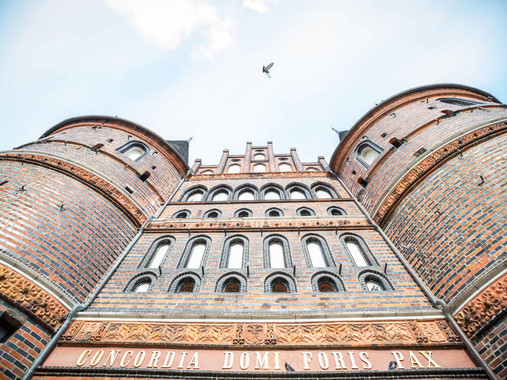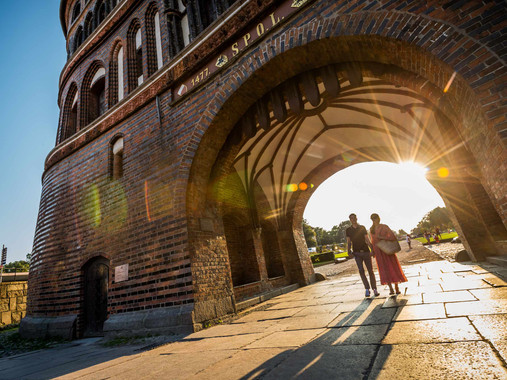Lübeck
Lübeck’s famous landmark is one of Germany’s best-known monuments.
The city gate was built between 1464 and 1478 along the lines of Dutch models. It served both as a form of defence and as a symbol of the city’s prestige. Above the round-arched gateway entrance of the twin-towered construction, the inscription CONCORDIA DOMI FORIS PAX (unity within, peace without) can clearly be seen in golden letters. Nearly every visitor is astonished by its odd tilt and sunken South tower. As only the towers stand separately on a foundation consisting of a wooden grid with the heavy middle tract also resting on them, the towers subsided unevenly into the marshy ground. In 1863, the Holsten Gate looked an appalling sight. By a majority of just one single vote, the city parliament decided to restore the gate and began extensive restoration efforts. It wasn't until 70 years later that the subsidence could be stopped.
In the interior of the Holsten Gate, a museum displays interesting material relating to the “Power of Trade”. Historic ship models, suits of armour, weapons, legal instruments and merchandise give a brief glimpse into the time of the Hanseatic League.
On the map
Holsten Gate
Holstentorplatz
23552 Lübeck
Deutschland
Phone: 0451 1224129
Fax: 0451/ 1 22 41 83
E-mail: mkk@luebeck.de
Website: www.museum-holstentor.de
General information
Price Info: Adults € 8
Reduced & Children (up to 18 years) free entry
Lübeck Day Pass € 12
Lübeck Day Pass (valid for two days) € 16
Monday
The bus stop Holstentorplatz is directly in front of the museum. You can reach it with all bus lines: 1, 2, 5, 6, 7, 9, 10, 11, 15, 16, 17, 21, 30, 31, 32, 39 and 40.
Unfortunately, there is no elevator to the upper floors where the exhibition is located. The museum is unfortunately not suitable for wheelchair users due to its many spiral staircases. Guide dogs are very welcome.

